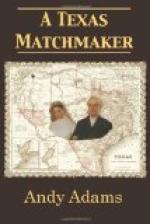While this work was being done, the herd of geldings was held close at hand. After the first riding, four horses were the daily allowance of each rider. With the amount of help available, this allowed twelve to fifteen horses to the man, so that every animal was ridden once in three or four days. Rather than corral, we night-herded, penning them by dawn and riding our first horse before sun-up. As they gradually yielded, we increased our number to six a day and finally before the breaking was over to eight. When the work was finally over they were cut into remudas of fifty horses each, furnished a gentle bell mare, when possible with a young colt by her side, and were turned over to a similar treatment as was given the fillies in forming manadas. Thus the different remudas at Las Palomas always took the name of the bell mare, and when we were at work, it was only necessary for us to hobble the princess at night to insure the presence of her band in the morning.
When this month’s work was two thirds over, we enjoyed a holiday. All good Texans, whether by birth or adoption, celebrate the twenty-first of April,—San Jacinto Day. National holidays may not always he observed in sparsely settled communities, but this event will remain a great anniversary until the sons and daughters of the Lone Star State lose their patriotism or forget the blessings of liberty. As Shepherd’s Ferry was centrally located, it became by common consent the meeting-point for our local celebration. Residents from the Frio and San Miguel and as far south on the home river as Lagarto, including the villagers of Oakville, usually lent their presence on this occasion. The white element of Las Palomas was present without an exception. As usual, Miss Jean went by ambulance, starting the afternoon before and spending the night at a ranch above the ferry. Those remaining made a daybreak start, reaching Shepherd’s by ten in the morning.
While on the way from the ranch to the ferry, I was visited with some misgivings as to whether Esther McLeod had yet returned from San Antonio. At the delivery of San Miguel’s cattle at Las Palomas, Miss Jean had been very attentive to Tony Hunter, Esther’s brother-in-law, and through him she learned that Esther’s school closed for the summer vacation on the fifteenth of April, and that within a week afterward she was expected at home. Shortly




